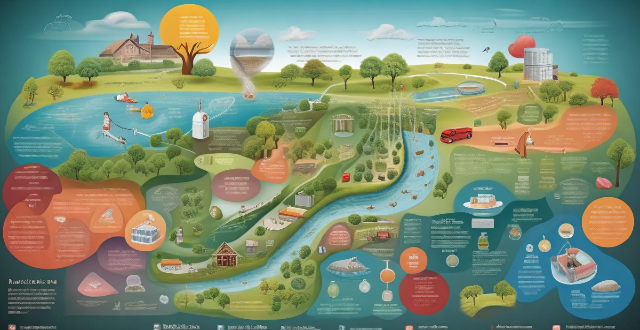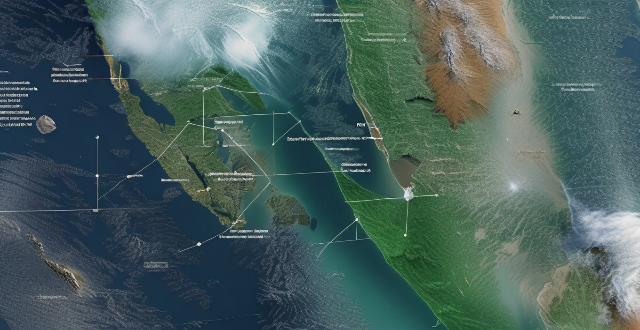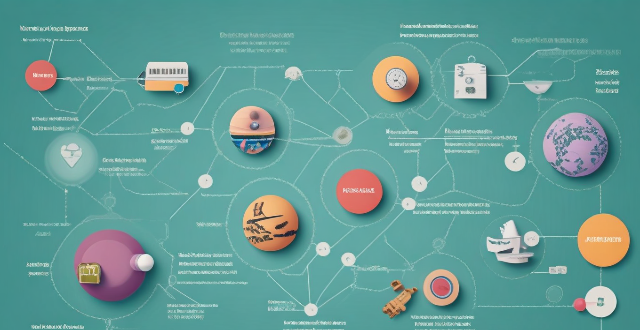Human Environment

How do scientists use climate models to study the impact of human activities on the environment ?
Climate models are mathematical tools used to simulate the Earth's climate system and study the impact of human activities on the environment. The process involves data collection, model construction, scenario analysis, prediction and projection, and continuous validation and refinement. These models help policymakers make informed decisions about reducing greenhouse gas emissions and adapting to climate change.

How does climate data analysis aid in understanding the impact of human activities on the environment ?
Climate data analysis aids in understanding the impact of human activities on the environment by identifying climate change indicators, analyzing atmospheric composition, monitoring land use changes, assessing water resources, and evaluating energy consumption. By collecting and analyzing various types of climate data, scientists can identify patterns and trends that help them understand how human activities are affecting the planet. This information is critical for developing strategies to mitigate the negative impacts of human activities on the environment and promote sustainable development.

How do human activities impact the environment and what ethical responsibilities do we have ?
Summary: Human activities such as pollution, deforestation, overfishing, and climate change have a significant negative impact on the environment. To fulfill our ethical responsibility towards the environment, we should reduce, reuse, recycle, support sustainable practices, advocate for environmental protection, and educate others about the importance of preserving the planet for future generations.

How does electronic waste affect the environment if not recycled ?
Electronic waste, or e-waste, refers to discarded electronic devices such as computers, smartphones, and televisions. Improper disposal of these items can have severe consequences for the environment, including the release of toxic chemicals into soil, water, and air. These chemicals can cause health problems for both humans and wildlife. Non-recycled e-waste also occupies valuable landfill space and contributes to soil contamination, water pollution, and air pollution. Proper recycling of electronic waste is essential to protect the environment and human health, conserve natural resources, and minimize the impact on landfills.

What are the different types of sensors used in environmental monitoring ?
Environmental monitoring involves the use of various sensors to collect data on different environmental parameters. These sensors include temperature sensors, humidity sensors, pressure sensors, light sensors, and chemical sensors. Temperature sensors measure the temperature of the environment and are crucial for monitoring weather patterns, climate change, and the impact of human activities on the environment. Humidity sensors measure the moisture content in the air and are essential for monitoring weather patterns, air quality, and the impact of human activities on the environment. Pressure sensors measure the force per unit area exerted by a fluid or gas and are crucial for monitoring weather patterns, air quality, and the impact of human activities on the environment. Light sensors measure the intensity and wavelength of light in the environment and are essential for monitoring solar radiation, atmospheric conditions, and the impact of human activities on the environment. Chemical sensors measure the presence and concentration of specific chemicals in the environment and are crucial for monitoring air and water quality, soil contamination, and the impact of human activities on the environment. Overall, these sensors help us understand the state of our environment and take necessary actions to protect it.

Can climate change be considered a human rights issue ?
The text discusses the impact of climate change on human rights, focusing on health and safety, access to resources, displacement and migration, and intersectionality. It argues that climate change can be considered a human rights issue because it has the potential to violate several fundamental rights enshrined in international law. The text concludes that addressing climate change is crucial for protecting and promoting human rights globally.

How can we ensure that climate action is consistent with human rights ?
To ensure that climate action is consistent with human rights, we need to adopt a holistic approach that takes into account the social, economic, and environmental dimensions of sustainability. Some strategies include recognizing the interdependence between climate action and human rights, integrating human rights into climate policy, ensuring transparency and accountability, promoting participatory democracy, strengthening legal frameworks, and building capacity and providing support to vulnerable populations. By doing so, we can create a more equitable and just world for all.

What are the legal frameworks for addressing climate change and human rights ?
The text discusses the various legal frameworks that exist to address climate change and human rights, including international agreements, national laws, and regional regulations. It highlights the importance of a multifaceted approach to tackle this complex issue and emphasizes the need to protect vulnerable communities' rights in the process. The text also provides examples of specific initiatives taken by different entities such as the United Nations, the United States, the European Union, the African Union, and the Association of Southeast Asian Nations. Overall, the text suggests that by working together at these different levels, we can create a more equitable and sustainable future for all.

What is environmental psychology, and how does it relate to climate issues ?
The topic is about Environmental Psychology, whichThe topic is about Environmental Psychology, which that studies the interrelation which is a branch of psychology that studies the interrelationships between humans and their surroundings. It explores how our physical surroundings influence our thoughts, emotions, behaviors, and well-being. The key concepts in environmental psychology include perception of the environment, cognitive maps, environmental preferences, human behavior in context, restorative environments, and urban design and planning. Environmental psychology relates to climate issues by understanding public perception, promoting pro-environmental behavior, designing sustainable environments, mitigating climate anxiety, and enhancing environmental education. It plays a crucial role in understanding human attitudes, perceptions, and behaviors concerning climate issues. By applying its principles, we can better promote sustainable practices, design supportive environments, and help individuals and communities adapt to the challenges posed by climate change.

How does climate change affect children's rights to a healthy environment ?
This article explores the impact of climate change on children's right to a healthy environment, highlighting various health, nutritional, psychological, and educational implications. It emphasizes that addressing climate change is crucial for safeguarding children's rights and future well-being.

Is it ethical to continue using fossil fuels given their negative impact on the environment ?
The text discusses the ethical implications of continuing to use fossil fuels given their negative impact on the environment. It highlights the harmful pollutants released by burning fossil fuels, including carbon dioxide, sulfur dioxide, nitrogen oxides, and particulate matter. These pollutants contribute to global warming, acid rain, and air pollution, which have negative effects on human health, biodiversity, and the environment. The text suggests that we have a moral obligation to protect the environment for future generations and raises questions about environmental justice and equity. However, some argue that transitioning away from fossil fuels would be too costly and disruptive to economies around the world. The text also explores alternatives to fossil fuels, such as solar power, wind power, hydropower, geothermal energy, and biomass. In conclusion, the text argues that it is ethically questionable to continue using fossil fuels as our primary source of energy and that we should focus on developing and implementing cleaner, renewable sources of energy to mitigate our impact on the environment.

Can AI replace human decision-making in complex situations ?
Artificial intelligence (AI) has made significant strides in recent years, leading to discussions about its potential to replace human decision-making in complex situations. While AI possesses certain advantages, such as speed and accuracy, it still faces limitations that prevent it from fully replacing humans in decision-making processes. Advantages of AI in decision-making include speed and efficiency, accuracy and consistency, and scalability. However, AI also has limitations such as lack of creativity, ethical considerations, and interpretability. Examples of complex situations where AI may not replace human decision-making include medical diagnosis, legal judgments, and business strategy. In conclusion, while AI has the potential to assist humans in decision-making processes, it cannot fully replace them in complex situations. The combination of AI's analytical capabilities and human creativity, ethics, and intuition will likely lead to better outcomes in these scenarios.

Is the greenhouse effect a natural phenomenon or human-induced ?
The greenhouse effect is a natural process that helps maintain Earth's climate, but human activities have significantly increased greenhouse gas concentrations, leading to an enhanced or "human-induced" effect. This has resulted in global warming and other environmental issues, such as rising sea levels, extreme weather events, and ocean acidification.

What are the responsibilities of governments in addressing climate change and protecting human rights ?
Governments worldwide have a crucial role in addressing climate change and protecting human rights. Their responsibilities include legislation, public awareness, research, international cooperation, adaptation measures, protection of human rights, alignment with Sustainable Development Goals, and monitoring progress. By taking proactive steps in these areas, governments can create a sustainable future for all citizens while respecting their fundamental rights.

How does a Series Hybrid Electric Vehicle impact the environment ?
Series hybrid electric vehicles (SHEVs) have a positive impact on the environment through reduced emissions and improved fuel efficiency. However, challenges such as battery production and waste management must be addressed to maximize their environmental benefits. The overall impact also depends on factors like the source of electricity for charging and vehicle design efficiency.

How might global warming influence future patterns of human migration ?
Global warming is poised to significantly influence future patterns of human migration through various channels, including sea level rise, changes in agricultural zones, extreme weather events, economic impacts, health considerations, and social and political factors. These changes will contribute to shifts in where and how humans choose to live, forcing coastal communities to relocate, increasing the risk of flooding in currently habitable areas, movement away from regions that become too hot or dry for farming, shifts toward more favorable climates for growing crops, increased frequency and intensity of extreme weather events, decline in traditional industries like fishing or agriculture in certain regions due to changing conditions, growth in new industries related to renewable energy or climate adaptation in other areas attracting workers, spread of diseases like malaria and dengue fever to new regions as the organisms that carry them move into warmer areas making some areas less hospitable for human habitation due to heat-related illnesses becoming more common, conflicts over resources like water and arable land which may be exacerbated by climate change, and government policies on resettlement and climate adaptation measures that could either facilitate or hinder migration.

Is climate variability increasing due to human activities, such as greenhouse gas emissions ?
The text discusses the topic of whether climate variability is increasing due to human activities, especially greenhouse gas emissions. It explains that climate variability refers to the range of weather conditions in a region and that natural factors can influence it. However, the focus is on the role of human activities, such as burning fossil fuels for energy, deforestation, and industrial processes, which have led to a significant increase in greenhouse gas emissions. These emissions trap heat in the Earth's atmosphere, causing a warming effect known as the greenhouse effect. The text then explains that the increase in greenhouse gas concentrations has several effects on climate variability, including changes in temperature, precipitation patterns, sea level rise, and extreme weather events. It also mentions that there is a scientific consensus that human activities are the primary driver of recent climate change. In conclusion, the text states that climate variability is indeed increasing due to human activities, particularly greenhouse gas emissions, and that global efforts to reduce these emissions and mitigate the impacts of climate change are crucial.

How can we balance economic development with climate action and human rights protection ?
Balancing economic development with climate action and human rights protection requires prioritizing sustainable development, integrating climate action into economic planning, protecting human rights, and collaborating across sectors. Governments and businesses should adopt policies and practices that promote renewable energy sources, reduce greenhouse gas emissions, encourage investment in green technologies, support small-scale farmers, promote fair trade practices, develop national climate plans, invest in research and development of new technologies, provide incentives for eco-friendly behaviors, ensure equal access to education, healthcare, and other basic services, protect the rights of marginalized communities, promote gender equality, enforce laws that protect workers' rights, establish cross-sectoral partnerships, encourage dialogue and consultation between stakeholders, support local initiatives, and encourage international cooperation.

How effective are current policies in preventing human trafficking, especially affecting women and girls ?
This text discusses the effectiveness of current policies in preventing human trafficking, focusing on international cooperation, legal measures, public awareness campaigns, protection and support services, economic development initiatives, and technology and innovation. It highlights that while these policies have made strides in raising awareness and strengthening legal frameworks against human trafficking, particularly affecting women and girls, there is still much work to be done. The complexity of the issue demands a multifaceted approach that combines law enforcement with social services, international cooperation with grassroots action, and traditional methods with innovative solutions. Continuous evaluation and adaptation of these policies are necessary to ensure they remain effective in protecting vulnerable populations from this grave violation of human rights.

Why is it important to address violence against women as a human rights issue ?
Violence against women is a widespread problem that violates basic human rights and has far-reaching consequences for individuals, families, communities, and society at large. Addressing violence against women as a human rights issue is essential for upholding these basic rights, promoting gender equality, breaking the cycle of poverty and marginalization, and fulfilling our legal obligations under international law. By raising awareness about this issue and working towards creating a world where all individuals can live free from fear and violence, we can help create a more equitable and just society for all.

Is there a risk that AI could replace human referees or umpires in sports ?
The article discusses the potential risks and benefits of using Artificial Intelligence (AI) in sports officiating. The benefits include improved accuracy, increased efficiency, and consistency across games. However, there are also risks such as lack of human judgment, cost and accessibility, and potential for bias. It is important to address these risks and ensure that AI systems complement rather than replace human referees or umpires.

How can I create an environment that encourages creative expression ?
Creating an environment that encourages creative expression is essential for fostering innovation, personal growth, and problem-solving skills. Here are some tips on how to create such an environment: 1. Set the tone by making everyone feel comfortable sharing their ideas and opinions without fear of judgment or criticism. 2. Provide opportunities for self-expression through various forms of media, such as writing, drawing, music, or dance. 3. Foster collaboration by encouraging teamwork and brainstorming sessions where everyone feels valued and heard. 4. Create a safe space where people feel comfortable taking risks and making mistakes. 5. Offer incentives and recognition to motivate individuals to continue exploring their imagination. 6. Provide resources and tools that support creative expression, such as art supplies, software, or access to workshops and training programs. 7. Encourage time for reflection and inspiration by providing regular breaks, mindfulness exercises, or a quiet space for contemplation. 8. Promote diversity and inclusion to encourage different perspectives and ideas, leading to more creative solutions.

In what ways do extreme weather events influence human behavior and psychological well-being ?
Extreme weather events, such as hurricanes, floods, heatwaves, and droughts, have significant impacts on human behavior and psychological well-being. These effects can be seen in various aspects of life, including physical health, mental health, social interactions, and economic stability. The physical health impacts include increased risk of injury or death, exacerbation of chronic conditions, and spread of disease. The mental health impacts include acute stress reaction, post-traumatic stress disorder (PTSD), grief and loss. The social interactions impacts include community cohesion and disruption of social networks. The economic stability impacts include financial strain and job loss and unemployment. In conclusion, extreme weather events have far-reaching impacts on human behavior and psychological well-being that extend beyond the initial incident itself. Addressing these challenges requires comprehensive strategies that consider both short-term relief efforts and long-term resilience building measures aimed at enhancing individual, community, and societal adaptive capacities.

What is the optimal environment for studying effectively at home ?
The provided text offers a comprehensive guide on creating an optimal study environment at home. It emphasizes the importance of choosing a quiet area with comfortable seating and adequate lighting. The text suggests keeping the study area clean, clutter-free, and properly organized with essential materials within reach. It also recommends minimizing distractions by controlling electronics, using do not disturb signs, and scheduling short breaks. Personalizing the space with motivational decor, personal touches, and maintaining a comfortable temperature is also advised. Overall, the text aims to help readers create a conducive study environment that enhances focus and productivity.

How does PPE contribute to creating a safe work environment ?
PPE's Role in Creating a Safe Work Environment Personal Protective Equipment (PPE) is vital for establishing a safe work environment by providing a physical barrier between workers and potential hazards, reducing the risk of injuries and illnesses. PPE contributes to safety in various ways, including preventing direct contact with hazardous substances, reducing exposure to harmful agents, providing physical support and protection, enhancing visibility and awareness, promoting compliance with regulations, encouraging responsible behavior, and contributing to ergonomic well-being. By implementing and maintaining the use of PPE, employers can significantly reduce the number of work-related injuries and illnesses, creating a safer and more secure work environment for all employees.

How can we encourage children to be more environmentally conscious ?
To encourage children to be more environmentally conscious, parents and educators can lead by example, educate them about the environment, involve them in eco-friendly activities, and encourage small changes in their daily routine. By doing so, they can help instill a sense of responsibility towards the environment in the younger generation.

How can parents create a positive learning environment through home teaching strategies ?
Creating a positive learning environment at home is crucial for children's academic success and overall well-being. Here are some strategies parents can use to foster such an atmosphere: 1. Establish a dedicated learning space that is quiet, organized, and comfortable. 2. Set clear expectations and goals with your child, and celebrate their achievements to boost confidence and motivation. 3. Foster a love for learning by encouraging curiosity, introducing new materials, and leading by example. 4. Provide support and encouragement by offering help when needed, praising effort over outcomes, and fostering a growth mindset. By implementing these strategies, parents can create a positive learning environment that encourages curiosity, exploration, and continuous growth for their children.